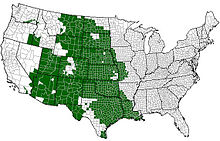Woodhouse's toad
| Woodhouse's toad | |
|---|---|

| |
| Scientific classification | |
| Domain: | Eukaryota |
| Kingdom: | Animalia |
| Phylum: | Chordata |
| Class: | Amphibia |
| Order: | Anura |
| Family: | Bufonidae |
| Genus: | Anaxyrus |
| Species: | A. woodhousii
|
| Binomial name | |
| Anaxyrus woodhousii (Girard, 1854)
| |

| |
| United States range of A. woodhousii | |
| Synonyms | |
|
Bufo woodhousii Girard, 1854 | |
Woodhouse's toad (Anaxyrus woodhousii) is a medium-sized (4 inches or 10 centimetres)
Taxonomy
Woodhouse's toad was first described in 1854 by the French herpetologist Charles Frédéric Girard. He gave it the name Bufo woodhousii in honor of the American physician and naturalist Samuel Washington Woodhouse.[2] The large genus Bufo was split by Frost et al. in 2006, with the North American species being included in the genus Anaxyrus and this toad becoming A. woodhousii.[3][4] There are three recognised subspecies:[5]
- Rocky Mountain toad –
- East Texas toad – Anaxyrus woodhousii velatus (Bragg and Sanders, 1951)[7]
- Southwestern Woodhouse's toad – Anaxyrus woodhousii australis (Shannon & Lowe, 1955)[8]
At one time,
Description
Woodhouse's toad is a robust amphibian and can grow to a maximum snout-vent length of 127 mm (5 in). The head has prominent cranial crests in front of and in between the eyes. The parotoid glands are long and large. The dorsal surface of this toad is grayish-brown or yellowish-brown and it is speckled with small dark spots. There is a narrow pale line running along the spine. The belly is rather paler and is usually unspotted. The male has a single vocal sac on his throat. His call resembles the bleat of a sheep and lasts from one to three seconds.[9][10]
Distribution and habitat
Woodhouse's toad is found in North America at altitudes of up to 2,500 metres (8,200 ft). Its range extends from Mexico in the south to

Behavior
Woodhouse's toad is
Status
Woodhouse's toad has a very wide range and presumed large total population. It is able to live in a number of types of habitat and can tolerate some modification to its habitat. The population seems steady and no particular threats have been identified so the
References
- ^ . Retrieved 17 July 2023.
- ^ Beltz, Ellin (2006). "Woodhouse, Samuel Washington". Scientific and Common Names of the Reptiles and Amphibians of North America - Explained. Retrieved 2014-11-17.
- ^ Howard Clark. "Arizona toad (Anaxyrus microscaphus)". Tucson Herpetological Society. Retrieved 2014-11-16.
- ^ Frost, D. R., T. Grant, J. Faivovich, R. H. Bain, A. Haas, C. F. B. Haddad, R. O. de Sá, A. Channing, M. Wilkinson, S. C. Donnellan, C. J. Raxworthy, J. A. Campbell, B. L. Blotto, P. E. Moler, R. C. Drewes, R. A. Nussbaum, J. D. Lynch, D. M. Green, and W. C. Wheeler. 2006. The amphibian tree of life. Bulletin of the American Museum of Natural History 297: 1–370
- ^ "Order Anura: Frogs and Toads". Checklist of Amphibian Species and Identification Guide. USGS. 2013-02-02. Retrieved 2014-11-17.
- ^ Girard, C. 1854. A list of North American bufonids, with diagnoses of new species. Proceedings of the Academy of Natural Sciences of Philadelphia 7: 86–88.
- ^ a b Bragg, A. N., and O. Sanders. 1951. A new subspecies of the Bufo woodhousii group of toads (Salientia: Bufonidae). Wasmann Journal of Biology. San Francisco 9: 363–378
- ^ Shannon, F. A., and C. H. Lowe, Jr. 1955. A new subspecies of Bufo woodhousei from the inland Southwest. Herpetologica 11: 185–190.
- ^ Jim Rorabaugh. "Woodhouse's toad (Anaxyrus woodhousii)". Tucson Herpetological Society. Retrieved 2014-11-17.
- ^ a b "Woodhouse's Toad, Bufo woodhousii". Checklist of Amphibian Species and Identification Guide. USGS. Retrieved 2014-11-17.
- ^ a b Brian K. Sullivan (2005). "Anaxyrus woodhousii". AmphibiaWeb. Retrieved 2014-11-15.
- ^ Sanders, O. 1986. The heritage of Bufo woodhousei Girard in Texas (Salientia: Bufonidae). Occasional Papers of the Strecker Museum. Waco, Texas 1: 1–28.
- ^ Sullivan, B. K., K. B. Malmos, and M. F. Given. 1996. Systematics of the Bufo woodhousii complex (Anura: Bufonidae): advertisement call variation. Copeia 1996: 274–280.
- Frost, D. R.; Grant, T.; Faivovich, J. N.; Bain, R. H.; Haas, A.; Haddad, C. L. F. B.; De Sá, R. O.; Channing, A.; Wilkinson, M.; Donnellan, S. C.; Raxworthy, C. J.; Campbell, J. A.; Blotto, B. L.; Moler, P.; Drewes, R. C.; Nussbaum, R. A.; Lynch, J. D.; Green, D. M.; Wheeler, W. C. (2006). "The Amphibian Tree of Life". Bulletin of the American Museum of Natural History. 297: 1–291. S2CID 86140137.
- Pauly, G. B.; Hillis, D. M.; Cannatella, D. C. (November 2004). "The History of a Nearctic Colonization: Molecular Phylogenetics and Biogeography of the Nearctic Toads (Bufo)". S2CID 198155461.
- "Anaxyrus woodhousii". Integrated Taxonomic Information System. Retrieved 9 October 2014.
External links
- "Woodhouse's toad" at the Encyclopedia of Life
- Anaxyrus woodhousii in the CalPhotos photo database, University of California, Berkeley
- Western Soundscape Archive - Western Woodhouse's Toad recording

